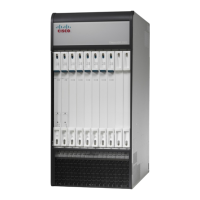Step 8
Enter port ethernet slot/port to enter the Ethernet Port Configuration mode. slot is the actual chassis slot in which the
MIO/UMIO card is installed. This could be either slot number 5 or 6. port is the physical port on the IO/UMIO that will
be used. This will be either port 1 or 2. Port 1 is the top most port.
[local]host_name(config)# port ethernet slot/port
[local]host_name(config-port-slot/port)#
Step 9
Bind the port to the interface that you created in Step 2. Binding associates the port and all of its settings to the interface.
Enter the following commands:
[local]host_name(config-port-slot/port)# bind interface interface_name local
[local]host_name(config-port-slot/port)# no shutdown
interface_name is the name of the interface that you configured in Step 3.
Step 10
Optional – Configure the port speed by entering the following command:
medium { auto | speed { 10 | 100 | 1000 } duplex {full | half} }
DescriptionKeyword/Variable
NOTE: Currently MIO/UMIO ports 1 and 2 support link speeds of 1000, 100,
or 10 Mbps. The ports will auto-negotiate its speed based on the fastest link
partner capability.
auto
NOTE: Currently for MIO/UMIO ports 1 and 2 the speed setting is ignored
since the port always operates in auto mode.
The possible rates are:
•
10 = 10 Mbps
•
100 = 100 Mbps
•
1000 = 1000 Mbps
speed
You can implement either a full or half duplex mode.
NOTE: Ethernet networking rules dictate that if a device whose interface is
configured to auto-negotiate is communicating with a device that is manually
configured to support full duplex mode, the first device negotiates with the
manually configured speed of the second device, but only communicates in half
duplex mode.
duplex
Step 11
Enter exit to exit the Ethernet Interface Configuration mode.
[local]host_name(config-port-slot/port)# exit
[local]host_name(config)#
ASR 5500 Installation Guide
103
Initial System Configuration
Configuring the Ethernet Management Interface

